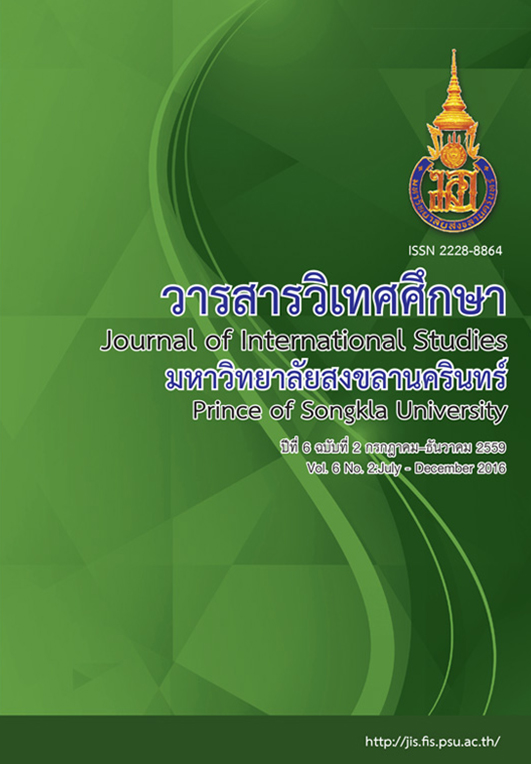Effects of Using Captioned and Keyword-only Pictures on Grade 2 Learners’ English Speaking Ability
Main Article Content
Abstract
The purposes of this study were to examine the effects of using captioned and keyword-only pictures on Grade 2 learners’ English speaking ability and to examine factors affecting their English speaking ability. The participants were recruited from 49 Grade 2 learners (25 females and 24 males) in a public primary school in Songkla, southern Thailand. They were selected by purposive sampling and randomly assigned into two experimental groups: captioned picture group and keyword-only picture group. The data were collected from pre-, post-, retention tests and semi-structured interview. Following CEFR oral assessment criteria, the results revealed that in the captioned pictures group, Grade 2 learners’ English speaking ability significantly increased from poor level to fair level, specifically in ‘range’ and ‘accuracy’ (Z = -2.236, p <.05). For keyword-only picture group, it was found that the learners’ speaking performance increased from poor level to fair and good levels at the significant difference 0.01 (Z = -3.145, p <.01). The three highly improved sub-skills were ‘interaction’, ‘fluency’ and ‘range’. For further studies, the researcher should use a larger sample size and add a control group. It may well be interesting to compare the effects of using multi-modalities (pictures, keywords and sound) and bi-modalities (pictures and sound) on learners’ English speaking ability.
Article Details
Statements and opinions expressed in articles herein are those of the authors and do not necessarily reflect the position of the editors or publisher.
Article, information, text, image, etc. which are published in Journal of International Studies, belong to Journal of International Studies. If anybody or any organization would like to use part or whole of them, they must receive written permission from Journal of International Studies before usage.
References
Al-Ja Afari, I. S. (2013). Using pictures in vocabulary in Grades 5 and 6 classrooms, Sharqiya South Region.
Bowen, B. (1982). LOOK Here! Visual aids in language teaching. Macmillan Publishers Ltd. London.
Brown, H. D, (2001). Teaching by principals. Pearson Education, New York.
Chang, C. S. & Read, J. (2007). Support for foreign language listeners: Its effectiveness and limitations. RELC. 38(3), 375 - 395.
Clark, J. M. & Paivio, A. (1991). Dual coding theory and education. Educational Psychology Review, 3(3), 149 -170.
Cook, G. (2000). Language play, language learning. Oxford: Oxford University Press.
Colon-Vila, L. (1997). Storytelling in an ESL classroom. Teaching Pre K-8, 27(5), 58 - 59.
Danan, M. (2004). Captioning and subtitling: Undervalued language learning strategies. Meta: Translators' Journal, 49, 67 - 77.
Dobson, M. J. (1992). Effective techniques for English conversation group. Washington: United States Information Agency.
Goh, C. (1999). How much do learners know about the factors that influence their listening comprehension ?, Hong Kong. Journal of Applied Linguistics, 4(1), 17 - 42.
Hayati, A., & Mohmedi, F. (2011). The effect of films with and without subtitles on listening comprehension of EFL learners. British. Journal of Educational Technology, 42(1), 181-192.
Kalyuga, S., Chandler, P., & Sweller, J. (1999). Managing split attention and redundancy in multimedia instruction. Applied Cognitive Psychology, 13, 351 - 371.
Lever, R., & Sénéchal, M. (2011). Discussing stories: On how a dialogic reading intervention improves kindergartners’ oral narrative construction. Journal of Experimental Child Psychology, 108(1), 1 - 24.
Linse, Caroline. T. (2005). Practical English language teaching: Young Learners. McGraw Hill, New York.
Lutz, S., & Huitt, W. (2003). Information processing and memory: Theory and applications. Educational Psychology Interactive. Valdosta, GA: Valdosta State University.
Mackay, P. (2006). Assessing young language learners. Cambridge: Cambridge University Press.
Madsen, H. J., Donald, B., & Ann, H. (1985). TESOL techniques and procedures. Cambridge, MA: Newbury House Publishers.
Mansourzadeh, N. (2014). A comparative study of teaching vocabulary through pictures and audio-visual aids to young Iranian EFL learners. Journal of Elementary Education, 24 (1), 47- 59.
Mayer, R. E. (2005). Cognitive theory of multimedia learning. In R.E. Mayer (Ed.), The Cambridge handbook of multimedia learning. New York: Cambridge University Press.
Mayer, R. E. (2009). Multimedia learning. New York: Cambridge University Press.
Paivio, A. (1971). Imagery and verbal processes. New York: Holt, Rinehart, and Winston.
Paivio, A. (1986). Mental representations. New York: Oxford University Press.
Pollock, E., Chandler, P., & Sweller, J. (2002). Assimilating complex information. Learning and Instruction, 12(1), 61- 86.
Rasheed, W. & Mohammed, H. (2007). The Impact of using pictures in vocabulary achievement for fifth primary pupil. College of Basic Education.
Rowe, M. L., Silverman, R. D., & Mullan, B. E. (2013). The role of pictures and gestures as nonverbal aids in preschoolers’ word learning in a novel language. Contemporary Educational Psychology, 38(2), 109 -117.
Shang, H. F. (2008). Listening strategy use and linguistic patterns in listening comprehension by EFL learners. The Intl. Journal of Listening. 22(1), 29 - 45.
Slattery, M. & Willis, J. (2001). English for primary teachers. Oxford: Oxford University Press.
Sticht, T. & James, J. (1984). Listening and reading. P.D. Perirson (Ed) Handbook of Reading Research. New York: Longman. 293 - 3 17.
Sweller, J., Van Merriënboer, J. J. G., & Paas, F. (1998). Cognitive architecture and instructional design. Educational Psychology Review, 10 (3), 251 - 296.
Taylor, G. (2005). Perceived processing strategies of students watching captioned video. Foreign Language Annals, 38 (3), 422 - 427.
University of Cambridge ESOL Examinations Research and Validation Group. (2009). Example of speaking performance at CEFR levels A 2 to C 2. Cambridge: Cambridge University Press.
Wright, A. (1990). Pictures for language learning. Cambridge: Cambridge University Press.
Yang, Y. T. C. & Chang, C. H. (2013). Empowering students through digital game authorship: Enhancing concentration, critical thinking, and academic achievement. Computer & Education, 68, 334 - 344.
Yoshii, M., & Flaitz, J. (2002). Second language incidental vocabulary retention: The effect of text and picture annotation types. CALICO journal, 33 - 58.


